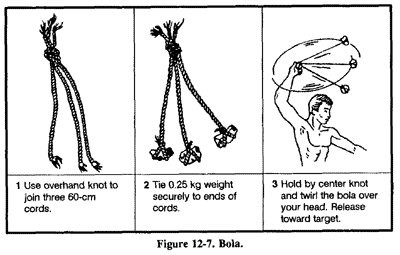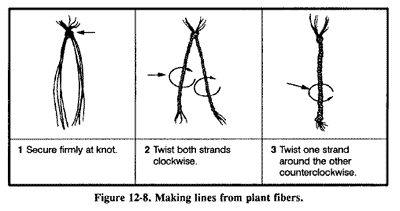Field-expedient Weapons - Lashing and Cordage
Many materials are strong enough for use as lashing and cordage. A number of natural and man-made materials are available in a survival situation. For example, you can make a cotton web belt much more useful by unraveling it. You can then use the string for other purposes (fishing line, thread for sewing, and lashing).

Natural Cordage Selection
Before making cordage, there are a few simple tests you can do to determine you materialís suitability. First, pull on a length of the material to test for strength. Next, twist it between your fingers and roll the fibers together. If it withstands this handling and does not snap apart, tie an overhand knot with the fibers and gently tighten. If the knot does not break, the material is usable. Figure 12-8 shows various methods of making cordage.
Lashing Material
The best natural material for lashing small objects is sinew. You can make sinew from the tendons of large game, such as deer. Remove the tendons from the game and dry them completely. Smash the dried tendons so that they separate into fibers. Moisten the fibers and twist them into a continuous strand. If you need stronger lashing material, you can braid the strands. When you use sinew for small lashings, you do not
need knots as the moistened sinew is sticky and it hardens when dry. You can shred and braid plant fibers from the inner bark of some trees to make cord. You can use the linden, elm, hickory, white oak, mulberry, chestnut, and red and white cedar trees. After you make the cord, test it to be sure it is strong enough for your purpose. You can make these materials stronger by braiding several strands together.

You can use rawhide for larger lashing jobs. Make rawhide from the skins of medium or large game. After skinning the animal, remove any excess fat and any pieces of meat from the skin. Dry the skin completely. You do not need to stretch it as long as there are no folds
to trap moisture. You do not have to remove the hair from the skin.
Cut the skin while it is dry. Make cuts about 6 millimeters wide. Start from the center of the hide and make one continuous circular cut, working clockwise to the hideís outer edge. Soak the rawhide for 2 to 4 hours or until it is soft. Use it wet, stretching it as much as possible while
applying it. It will be strong and durable when it dries.

Survival Skills
Survival Actions
Psyhology of Survival
Survival Planning and Survival Kits
Survival Medicine
Survival Medicine - Requirements for Maintenance of Health
Survival Medicine - Medical Emergencies
Survival Medicine - Lifesavings Steps
Survival Medicine - Bone And Joint Injury
Survival Medicine - Bites and Stings
Survival Medicine - Wounds
Survival Medicine - Environmental Injuries
Survival Medicine - Herbal Medicines
Shelters
Shelters - Shelter Site Selection
Shelters - Types of Shelters
Water Procurement - Water Sources
Water Procurement - Still Construction
Water Procurement - Water Purification
Firecraft - Basic Fire Principles
Firecraft - Site Selection and Preparation
Firecraft - Fire Material Selection
Firecraft - How to Build a Fire
Firecraft - How to Light a Fire
Food Procurement - Animals for Food
Food Procurement - Traps and Snares
Food Procurement - Killing Devices
Food Procurement - Fishing Devices
Food Procurement - Preparation of Fish and Game for Cooking and Storage
Survival Use of Plants - Edibility of Plants
Survival Use of Plants - Plants for Medicine
Poisonous Plants
Dangerous Animals - Insects and Arachnids
Dangerous Animals - Poisonous Snakes
Dangerous Animals - Dangerous Lizards
Dangerous Animals - Saltwater Dangers
Field-expedient Weapons, Tools, and Equipment
Field-expedient Weapons - Lashing and Cordage
Field-expedient Weapons - Rucksack Construction
Field-expedient Weapons - Clothing and Insulation
Field-expedient Weapons - Cooking and Eating
Desert Survival - Terrain
Desert Survival - Environmental Factors
Desert Survival - Need For Water
Desert Survival - Heat Casualties
Desert Survival - Precautions and Desert Hazards
Tropical Survival - Tropical Weather
Tropical Survival - Jungle Types
Tropical Survival - Travel Through Jungle Areas
Tropical Survival - Immediate Considerations
Tropical Survival - Water Procurement
Tropical Survival - Food
Cold Weather Survival - Cold Regions And Locations
Cold Weather Survival - Basic Principles Of Cold Weather Survival
Cold Weather Survival - Hygiene and Medical Aspects
Cold Weather Survival - Cold Injuries
Cold Weather Survival - Shelters
Cold Weather Survival - Fire
Cold Weather Survival - Water
Cold Weather Survival - Food
Cold Weather Survival - Travel
Cold Weather Survival - Weather Signs
Sea Survival - The Open Sea
Sea Survival - Seashores
Expedient Water Crossings - Rivers and Streams
Expedient Water Crossings - Rapids
Expedient Water Crossings - Rafts
Expedient Water Crossings - Flotation Devices
Expedient Water Crossings - Other Water Obstacles
Field-expedient Direction Finding - Using the Sun and Shadows
Field-expedient Direction Finding - Using the Moon and the Stars
Field-expedient Direction Finding - Making Improvised Compasses
Field-expedient Direction Finding - Other Means of Determining Direction
Signaling Techniques
Signaling Techniques - Means For Signaling
Signaling Techniques - Codes and Signals
Signaling Techniques - Aircraft Vectoring Procedures
Survival Movement in Hostile Areas - Phases of Planning
Survival Movement in Hostile Areas - Execution
Survival Movement in Hostile Areas - Return to Friendly Control
Camouflage - Personal Camouflage
Camouflage - Methods Of Stalking
Contact With People
Contact With People - The Survivorís Behavior
Survival In Man-made Hazards - The Nuclear Environment
Survival In Man-made Hazards - Biological Environments
Survival In Man-made Hazards - Chemical Environments
Survival Actions
Psyhology of Survival
Survival Planning and Survival Kits
Survival Medicine
Survival Medicine - Requirements for Maintenance of Health
Survival Medicine - Medical Emergencies
Survival Medicine - Lifesavings Steps
Survival Medicine - Bone And Joint Injury
Survival Medicine - Bites and Stings
Survival Medicine - Wounds
Survival Medicine - Environmental Injuries
Survival Medicine - Herbal Medicines
Shelters
Shelters - Shelter Site Selection
Shelters - Types of Shelters
Water Procurement - Water Sources
Water Procurement - Still Construction
Water Procurement - Water Purification
Firecraft - Basic Fire Principles
Firecraft - Site Selection and Preparation
Firecraft - Fire Material Selection
Firecraft - How to Build a Fire
Firecraft - How to Light a Fire
Food Procurement - Animals for Food
Food Procurement - Traps and Snares
Food Procurement - Killing Devices
Food Procurement - Fishing Devices
Food Procurement - Preparation of Fish and Game for Cooking and Storage
Survival Use of Plants - Edibility of Plants
Survival Use of Plants - Plants for Medicine
Poisonous Plants
Dangerous Animals - Insects and Arachnids
Dangerous Animals - Poisonous Snakes
Dangerous Animals - Dangerous Lizards
Dangerous Animals - Saltwater Dangers
Field-expedient Weapons, Tools, and Equipment
Field-expedient Weapons - Lashing and Cordage
Field-expedient Weapons - Rucksack Construction
Field-expedient Weapons - Clothing and Insulation
Field-expedient Weapons - Cooking and Eating
Desert Survival - Terrain
Desert Survival - Environmental Factors
Desert Survival - Need For Water
Desert Survival - Heat Casualties
Desert Survival - Precautions and Desert Hazards
Tropical Survival - Tropical Weather
Tropical Survival - Jungle Types
Tropical Survival - Travel Through Jungle Areas
Tropical Survival - Immediate Considerations
Tropical Survival - Water Procurement
Tropical Survival - Food
Cold Weather Survival - Cold Regions And Locations
Cold Weather Survival - Basic Principles Of Cold Weather Survival
Cold Weather Survival - Hygiene and Medical Aspects
Cold Weather Survival - Cold Injuries
Cold Weather Survival - Shelters
Cold Weather Survival - Fire
Cold Weather Survival - Water
Cold Weather Survival - Food
Cold Weather Survival - Travel
Cold Weather Survival - Weather Signs
Sea Survival - The Open Sea
Sea Survival - Seashores
Expedient Water Crossings - Rivers and Streams
Expedient Water Crossings - Rapids
Expedient Water Crossings - Rafts
Expedient Water Crossings - Flotation Devices
Expedient Water Crossings - Other Water Obstacles
Field-expedient Direction Finding - Using the Sun and Shadows
Field-expedient Direction Finding - Using the Moon and the Stars
Field-expedient Direction Finding - Making Improvised Compasses
Field-expedient Direction Finding - Other Means of Determining Direction
Signaling Techniques
Signaling Techniques - Means For Signaling
Signaling Techniques - Codes and Signals
Signaling Techniques - Aircraft Vectoring Procedures
Survival Movement in Hostile Areas - Phases of Planning
Survival Movement in Hostile Areas - Execution
Survival Movement in Hostile Areas - Return to Friendly Control
Camouflage - Personal Camouflage
Camouflage - Methods Of Stalking
Contact With People
Contact With People - The Survivorís Behavior
Survival In Man-made Hazards - The Nuclear Environment
Survival In Man-made Hazards - Biological Environments
Survival In Man-made Hazards - Chemical Environments